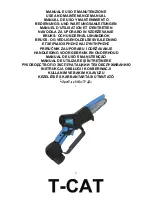
20
Securing workpiece (Fig. 32)
WARNING:
• It is extremely important to always secure the work-
piece properly and tightly with the vise. Failure to do so
can cause the tool to be damaged and/or the work-
piece to be destroyed. PERSONAL INJURY MAY
ALSO RESULT. Also, after a cutting operation, DO
NOT raise the blade until the blade has come to a com-
plete stop.
CAUTION:
• When cutting long workpieces, use supports that are
as high as the top surface level of the turn base. Do not
rely solely on the vertical vise and/or horizontal vise to
secure the workpiece.
Thin material tends to sag. Support workpiece over its
entire length to avoid blade pinch and possible KICK-
BACK.
Vertical vise (Fig. 33)
The vertical vise can be installed in two positions on
either the left or right side of the guide fence or the holder
assembly (optional accessory). Insert the vise rod into
the hole in the guide fence or the holder assembly and
tighten the screw to secure the vise rod.
Position the vise arm according to the thickness and
shape of the workpiece and secure the vise arm by tight-
ening the screw. If the screw to secure the vise arm con-
tacts the guide fence, install the screw on the opposite
side of vise arm. Make sure that no part of the tool con-
tacts the vise when lowering the handle fully and pulling
or pushing the carriage all the way. If some part contacts
the vise, re-position the vise.
Press the workpiece flat against the guide fence and the
turn base. Position the workpiece at the desired cutting
position and secure it firmly by tightening the vise knob.
CAUTION:
• The workpiece must be secured firmly against the turn
base and guide fence with the vise during all opera-
tions.
Horizontal vise (optional accessory) (Fig. 34)
The horizontal vise can be installed on the left side of the
base. By turning the vise knob counterclockwise, the
screw is released and the vise shaft can be moved rap-
idly in and out. By turning the vise knob clockwise, the
screw remains secured. To grip the workpiece, turn the
vise knob gently clockwise until the projection reaches its
topmost position, then fasten securely. If the vise knob is
forced in or pulled out while being turned clockwise, the
projection may stop at an angle. In this case, turn the
vise knob back counterclockwise until the screw is
released, before turning again gently clockwise.
The maximum width of the workpiece which can be
secured by the horizontal vise is 120 mm.
CAUTION:
• Grip the workpiece only when the projection is at the
topmost position. Failure to do so may result in insuffi-
cient securing of the workpiece. This could cause the
workpiece to be thrown, cause damage to the blade or
cause the loss of control, which can result in PER-
SONAL INJURY.
Holders and holder assembly
(optional accessories) (Fig. 35 & 36)
The holders and the holder assembly can be installed on
either side as a convenient means of supporting work-
pieces horizontally. Install them as shown in the figure.
Then tighten the screws firmly to secure the holders and
the holder assembly.
When cutting long workpieces, use the holder-rod
assembly (optional accessory). It consists of two holder
assemblies and two rods 12.
CAUTION:
• Always support long workpieces level with the top sur-
face of the turn base for accurate cuts and to prevent
dangerous loss of control of the tool.
OPERATION
CAUTION:
• Before use, be sure to release the handle from the low-
ered position by pulling the stopper pin.
• Make sure the blade is not contacting the workpiece,
etc. before the switch is turned on.
• Do not apply excessive pressure on the handle when
cutting. Too much force may result in overload of the
motor and/or decreased cutting efficiency. Push down
handle with only as much force as is necessary for
smooth cutting and without significant decrease in
blade speed.
• Gently press down the handle to perform the cut. If the
handle is pressed down with force or if lateral force is
applied, the blade will vibrate and leave a mark (saw
mark) in the workpiece and the precision of the cut will
be impaired.
• During a slide cut, gently push the carriage toward the
guide fence without stopping. If the carriage movement
is stopped during the cut, a mark will be left in the work-
piece and the precision of the cut will be impaired.
1.
Press cutting (cutting small workpieces) (Fig. 37)
Workpieces up to 50 mm high and 97 mm wide can be
cut in the following way.
Push the carriage toward the guide fence fully and
tighten two clamp screws which secure the slide poles
clockwise to secure the carriage. Secure the workpiece
with the vise. Switch on the tool without the blade making
any contact and wait until the blade attains full speed
before lowering. Then gently lower the handle to the fully
lowered position to cut the workpiece. When the cut is
completed, switch off the tool and WAIT UNTIL THE
BLADE HAS COME TO A COMPLETE STOP before
returning the blade to its fully elevated position.
CAUTION:
• Firmly tighten two clamping screws which secure the
slide poles clockwise so that the carriage will not move
during operation. Insufficient tightening may cause
unexpected kickback of the blade. Possible serious
PERSONAL INJURY may result.
Содержание LS0714L
Страница 10: ...10 61 62 95 96 92 001145 003946 ...
Страница 130: ...130 ...
Страница 131: ...131 ...
Страница 132: ...884547I997 IDE Makita Jan BaptistVinkstraat 2 3070 Belgium Makita Corporation Anjo Aichi Japan www makita com ...
















































